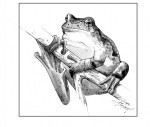
Jim Andrews, a herpetologist at Middlebury College, says it is a rare student who can pick out a gray treefrog on a tree when the frog is not calling.
Gray treefrogs are masters of disguise. Their bumpy, gray, patterned skin makes them look like a clump of lichen on the bark of a tree. Further, their skin changes color from white to green to dark gray, allowing them to blend in to their surroundings even better. (Yes, you read that correctly. Gray treefrogs can be green.) Add to this the fact that a large specimen is no longer than the length of your thumb, and it’s no wonder that these frogs are hard to spot.
But gray treefrogs are not only hard to spot, they are also overlooked. They are our area’s other treefrog, getting second billing to spring peepers. The call of spring peepers, when they’re in large numbers, sounds to me like sleigh bells and is a celebrated sign of spring. By the time the gray treefrog gets around to calling during the second week of June, however, we’ve moved on to summer thoughts.
It’s not that we don’t hear them, though. A group of chorusing male gray treefrogs, says Andrews, “is loud enough that it can hurt your head if you stand right in there. It resonates in your skull.”
Gray treefrogs are unusual in that they call from trees, not ponds or puddles, and they don’t only call during mating season. They seem to be moved to call whenever the temperature and humidity are just right, says Andrews.
This may be why they have a reputation for calling just before thunderstorms.
“It’s one of the few frogs you will hear in the woods in July when everyone else has shut up,” Andrews says, adding that scientists are not sure why they do this.
Hearing a lone gray treefrog’s musical trill can be confusing. They will call during the day, making them easy to confuse with a bird, although by late June, even the birds have become quiet. The sound is cricket-like, although the timing is early for crickets in our area.
According to the Vermont Reptile and Amphibian Atlas Project, headed by Andrews, gray treefrogs are primarily found in Vermont’s valleys, particularly the Champlain valley, and near Otter Creek, but also in the Connecticut River valley.
In New Hampshire, the Reptile and Amphibian Reporting Project (RAARP) gathers similar information about the presence of species within towns. Michael Marchand, a wetlands biologist with the New Hampshire Fish & Game Department’s Nongame & Endangered Species Program, runs the project. He characterizes gray treefrogs as being found in the southern two-thirds of the state, everywhere south of the White Mountains.
Many of RAARP’s 100 or so volunteers are clustered in the southeastern corner of the state, so records for the gray treefrog in New Hampshire are sketchier than the records for Vermont. Marchand is actively looking for more volunteers. Anyone interested in reptiles and amphibians can participate in the reporting project, from five-year-olds to herpetologists. Search for “RAARP” at www.wildlife.state.nh.us.
In Vermont, learn more about the Reptile and Amphibian Atlas Project at www.middlebury.edu/herpatlas.
Last year seemed to be a particularly good year for gray treefrogs. They were heard in a few new locations in Vermont and New Hampshire. Why the new reports? Marchand points out that amphibian populations go through boom-and-bust cycles. Last year might have been a boom year, although his own observations were so limited that he doesn’t want to draw any conclusions from them.
It was a warm spring and a hot summer, perhaps increasing the number of times gray treefrogs felt the urge to sing out.
Programs like New Hampshire’s RAARP and the Vermont Reptile and Amphibian Atlas are designed more to flag big losses in amphibian populations than small gains, but they are providing valuable data that may help scientists answer questions like this over the long term.
South of our area, in Delaware and points south and west, there is another, identical-looking version of the gray treefrog called Cope’s gray treefrog. Scientists tell the two species apart by counting their chromosomes (our version has an extra set), or by calculating the speed of the frog’s trill. It seems that a song of even slightly the wrong speed just doesn’t set female gray treefrogs’ hearts aflutter with desire, and the two species do not interbreed.
Given that the gray treefrog is such a master of stealth, it’s surprising that a closer look reveals something really flashy: the hidden undersides of this frog’s back legs are bright orange or yellow. What is literally true of gray treefrogs turns out to be philosophically true of every living thing. Something that is easy to overlook, on closer inspection, turns out to be truly colorful.


Discussion *